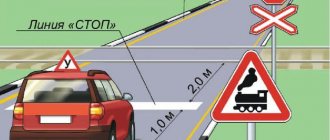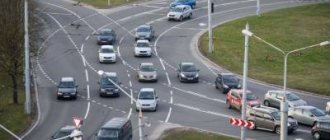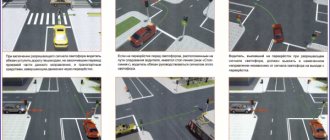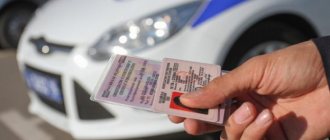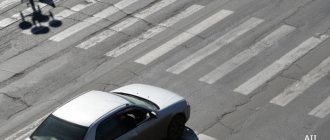Changing lanes does not raise any questions for experienced drivers. When driving on the highway and in dense city traffic, maneuvers occur automatically. An unintentional or forced violation of traffic rules may result in a fine or a traffic accident. Avoiding problematic situations will allow mutual respect between traffic participants and an understanding of when there is no need to take risks.
What is rebuilding?
Changing lanes is a maneuver in which a car leaves a previously occupied lane while maintaining the direction of travel. It is carried out taking into account the markings on the highway, which causes difficulties for drivers in difficult weather conditions and on bad roads where there are no directional signs. A ban on changing lanes is established using demarcation stripes on the road surface:
- Single continuous marking. Separates opposing flows and marks boundaries in dangerous places. In addition, it demarcates parking areas and areas for which entry is prohibited. Permanent solid stripes are marked with white paint, temporary stripes are marked with orange. To systematize the flow in one direction, a continuous line in the same direction is drawn on the road.
- Double solid line. Traffic controller on a road with 4 or more lanes (for example, 2 on each side). Crossing it in order to change lanes or turn around in the wrong place creates a dangerous situation.
- Single solid marking with a satellite - a dotted line on the left. Indicates areas where changing lanes is allowed only on one side.
- Wide continuous stripe. Indicates the edge of the roadway.
Where can you change lanes and where is it prohibited?
Changing lanes causes anxiety among inexperienced drivers. However, there are situations where even an experienced motorist may doubt the correctness of actions. The main taboo on changing lanes is regulated by a solid line, which is found in tunnels, in the area of bridges, sharp turns and bends. To avoid causing an accident and losing your license, the driver must pay attention to the marking lines and know when he has the right of way.
In the tunnel
Throughout the tunnel, the road lanes are divided by solid lines, which vetoes lane changes. It operates on Russian highways and is explained by the difference in temperature conditions. During the cold season, it is warmer in the tunnel than outside. As a result, when driving from a cold area to a warm one, wheel traction deteriorates, which leads to emergency situations when trying to maneuver.
Before driving through the tunnel, motorists are advised to decide on their lane. If the opportunity is missed, you need to change lanes after leaving, when the solid markings are replaced by dotted lines.
On Bridge
The rules do not contain information about the prohibition of changing lanes from one lane to another while crossing bridges. However, overtaking is strictly prohibited. If the driver needs to change lanes, he can do this without subsequently returning to the original lane and only in those places where this is permitted by markings (there is no continuous line).
On the ring
When traveling in this area, motorists must follow the rules for driving around roundabouts. You can change lanes if there is no continuous line on the road. During the maneuver, you should give way to vehicles driving directly in the adjacent lane.
At the crossroads
Controlled and unregulated intersections are complex sections of the road. When changing lanes, you need to give way not only to cars, but also to pedestrians and cyclists who follow the intended path. The rules do not prohibit changing lanes when entering intersections, and experienced drivers make the maneuver in advance. If you need to change lanes in a difficult area, you should remember the priority of vehicles moving on the right.
Traffic regulations (clause 11.4) prohibit overtaking on such sections of roads. However, it is difficult to do without it when changing lanes, so the best option would be to move in advance to the lane you are interested in:
- to move right/left – to the far right/left lane;
- to continue straight movement - on any path, taking into account the traffic light arrows.
At a pedestrian crossing
The rules do not prohibit changing lanes in this place, however, overtaking is strictly prohibited. An unsuccessful maneuver can threaten the health of pedestrians and impede their movement (stopping a car at a zebra crossing). In order to avoid nagging from traffic police officers and accidents, it is advisable to change lanes outside the crossings.
Traffic at intersections is a dangerous event
One inattentive movement of the driver when two intersecting roads are heavily congested can cost at least minor damage to the car, and at most the lives of everyone involved in the accident. It was to prevent such consequences that norms of behavior for all traffic participants were established at the legislative level. Many classes in driving schools are devoted to this topic. In addition, the government sometimes introduces many amendments to certain laws or regulations.
All this allows not only to reduce emergency situations at intersections, but also, accordingly, to save the lives of many people. The beginning of such a section of the road is indicated by a road sign "crossroads" . It is expected that drivers will concentrate additionally, pay attention to the previous designations and signs, according to which the trajectory of movement at the intersection is determined, and take a break from talking on the phone, which is what they so often sin on the road.
Rules for changing lanes
Information about changing lanes is set out in paragraph 8.4 of the Traffic Rules. The driver's action algorithm is simple:
- make sure you can maneuver;
- turn on the turn signals;
- must give way to vehicles moving in the required lane without changing direction;
- parallel cars on the right;
- smoothly reduce speed and calculate the distance to the nearest cars;
- take into account the speed of transport moving in an adjacent direction.
In practice, not all motorists maneuver correctly, resulting in a dangerous situation or collision. Information on how to behave in different traffic situations will help you avoid problems.
Mutual
When changing lanes at the same time, drivers have a lot of disputes. For example, when deciding what should do when maneuvering on a three-lane road. One car is driving in the far left lane and starts changing lanes into the middle one. The other seeks to get into the middle row from the far right lane.
According to the rules, in this case the driver of the car on the right has the advantage. To avoid lateral contact, the driver on the left must slow down and let cars on the right and vehicles that have changed lanes pass. It is important to take into account the behavior of other participants.
Between the rows
Such a maneuver is considered dangerous, especially for novice drivers. The restructuring should be done gradually and in advance. For example, when driving on a three-lane highway, changing from the far right or left lane to the opposite lane should be done in 2 stages, from row to row. First you should take the middle lane, and then move to the desired row. In this case, the pace of movement of other road users should be taken into account.
It is prohibited to cross 2 dividing lines at once during one lane change.
When there is interference on the right
This situation means that a car is moving to the right of the driver who plans to change lanes. You should skip it and only then carry out the maneuver. In the event of a mutual change of lanes, there is no interference, however, transport on the right has priority. If the question concerns a situation where a driver is moving on the left side, and a car on the right is changing lanes into his lane, you need to ignore the obstacle and only then change lanes yourself.
To the left lane
In this case, you need to rebuild correctly according to the general rules. The motorist should turn on the turn signal, slow down and let cars moving straight in the left lane pass. After this, you can begin rebuilding. The type of road (main, secondary) does not matter. The one who plans to rebuild always gives in. If they pass him by out of politeness, you can seize the moment.
Before the traffic light
It happens that motorists make the decision to change lanes before a traffic light. This happens, for example, if the far right lane is occupied and the green signal is on. You should act according to the general rules, but taking into account the following nuances:
- mandatory inclusion of turn signals (despite the absence of cars moving in the same direction);
- if the prohibitory signal is on, you must stop in front of the traffic light;
- When changing lanes, there is no need to specifically slow down the speed; you should maintain its average value.
When the road narrows
A sign warns in advance about the reduction of lanes on the highway. In this case, drivers should move in advance to the lane that will continue. In this case, the advantage of movement remains with cars moving along a non-constricted path. They must continue at the same speed. When changing lanes, you should let them pass and then make the maneuver.
Public transport
Rebuilding of trolleybuses, buses, and trams occurs according to general rules. If public transport moves along the lane that is allocated for it, then cars are allowed to occupy it when it is safe to change lanes or turn left.
However, the maneuver should be carried out promptly so as not to impede the traffic for which the lane is intended.
What is the penalty for incorrect maneuvering?
Drivers who break the rules when changing lanes do not always clearly understand how dangerous their actions can be. In many cases, the responsibility for the misconduct will be more serious than the time gained. The size of fines is determined depending on which rules were violated.
We described in detail what fine or other punishment is provided for incorrect maneuvering and what is considered a violation according to traffic rules in this article.
Marking violation
A motorist who violates the marking requirements on the roadway will be held accountable to the law in accordance with Part 1 of Art.
12.16 Code of Administrative Offences. Failure to comply with the requirements will result in a fine of 500 rubles (read about the penalties for crossing a solid marking line here). If the driver wanted to turn around from the lane intended for straight driving, or make a turn, in accordance with Part 2 of Art. 12.16 Code of Administrative Offences, he will be fined 1000-1500 rubles. In federal cities, the fine for violating lane markings when changing lanes may be increased.
At the crossroads
If the rules for changing lanes at intersections are violated, the offense is punishable by a fine in accordance with Art. 12.13 Code of Administrative Offences. When entering the intersection of roadways behind which a traffic jam has formed, the motorist creates an obstacle on the road.
Article 12.13 of the Code of Administrative Offenses of the Russian Federation. Violation of rules for crossing intersections
- Driving to an intersection or crossing a roadway in the event of a traffic jam that has forced the driver to stop, creating an obstacle to the movement of vehicles in the transverse direction, entails an administrative fine of one thousand rubles.
- Failure to comply with the requirement of the Traffic Rules to give way to a vehicle enjoying priority right of passage through intersections shall entail the imposition of an administrative fine in the amount of one thousand rubles.
This forces vehicles passing the section in the transverse direction to stop. Violation is punishable by a fine of 1000 rubles.
In the tunnel
It is prohibited for cars to change lanes when passing through the tunnel. Traffic should only be in designated lanes; maneuvers are not permitted.
The punishment is determined according to Article 12.16, since before entering the tunnel, signs are installed that determine the traffic mode. Fine 500 rubles.
Punishment for breaking the rules
Ignoring the rules may result in a fine, the amount of which depends on the type of violation:
- maneuvering without turning signals on – 500 rubles;
- ignoring the benefits of movement - 1000 rubles;
- moving continuous markings - 5,000 rubles or deprivation of rights for six months.
By making incorrect maneuvers, the driver risks being without a license and causing an accident involving third parties (pedestrians and other vehicles). This may result in administrative or criminal penalties, the severity of which depends on the nature of the accident. Knowledge of the traffic police rules and articles of violation allows traffic participants to be mutually polite, protects nerves, finances and health.

